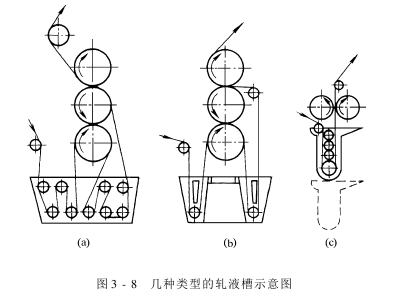Rolling car – rolling tank
The padding tank is one of the main components of the padding machine. It has different structural shapes and requirements according to the process requirements and operations of fabric finishing.
When soaking is the main requirement, the soaking time of the fabric in the treatment solution needs to be appropriately increased. Therefore, the volume of the liquid rolling tank is required to be larger, and multiple cloth guide rollers are arranged in the tank to increase the dipping time, such as the liquid rolling tank of the wire finishing machine, as shown in Figure 3-8(a). However, under certain circumstances, such as when padding dye solutions, not only a good degree of penetration and a necessary impregnation time are required, but also a small capacity of the padding tank is required, which is conducive to renewing the dye solution in the tank and reducing the amount of residual liquid. This is usually solved by using the mangle tank shown in Figure 3-8(b).
In recent years, the liquid squeeze tank shown in Figure 3-8(c) has also been adopted. Its characteristic is that when the fabric is immersed in the solution in the tank, it is pressed by small rollers to squeeze out the bubbles in the fabric and add heat. The upper liquid groove is deeper, which can increase the static pressure of the solution and facilitate the penetration of the solution into the fabric. This kind of liquid rolling tank is equipped with lifting equipment, and the bearing seat of the cloth guide roller in the tank is fixed on the frame to facilitate cloth threading and cleaning.
The material of the liquid rolling tank should be selected according to the chemical properties (corrosion conditions) of the solution. Generally, the materials of the rolling tank include wood, plastic, steel (A3), non-ferrous metals (green lead, copper, etc.), stainless steel, titanium plates, etc. At present, stainless steel tanks are most commonly used. In addition to its certain corrosion resistance, it also has the characteristics of light weight and convenient cleaning in the tank.

Liquid rolling The tank is installed under the roller, and the liquid filling pipe is installed in the middle position behind the tank. It is necessary to ensure that the liquid discharge from the liquid hole of the liquid adding pipe is smooth and even. This is especially important for pad dyeing and cannot be ignored. A drain valve is installed at the bottom of the tank to discharge waste liquid. Some also install pneumatic lifting and turning devices, and have powerful spray devices at the rollers to facilitate quick discharge of waste liquid and cleaning of the dye tank, and are suitable for quick cleaning and color change of small batches of dyeing. In order to heat, preserve or cool the solution, indirect steam pipes are often installed at the bottom or both sides of the tank or jackets are installed outside the tank to introduce steam or cooling water. However, it should be noted that the steam pressure must be appropriate to prevent damage to the manifold tank. Some machines are also equipped with automatic temperature control and automatic liquid level control devices to maintain a certain amount of liquid, gas and liquid.
AAAZXCASFWEFERH
Extendedreading:https://www.yingjietex.com/product/polyester-Two-way-stretch-satin-Printing-fabric.html
Extendedreading:
Extendedreading:
Extendedreading:
Extendedreading:
Extendedreading:
Extendedreading:
Extendedreading:
Extendedreading:
Extendedread





